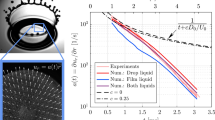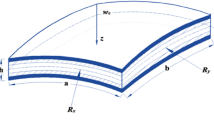Abstract
This work investigates the pressure amplification experienced behind a rigid, porous barrier that is exposed to a planar shock. Numerical simulations are performed in two dimensions using the full Navier–Stokes equations for a M = 1.3 incoming shock wave. An array of cylinders is positioned at some distance from a solid wall and the shock wave is allowed to propagate past the barrier and reflect off the wall. Pressure at the wall is recorded and the flowfield is examined using numerical schlieren images. This work is intended to provide insight into the interaction of a shock wave with a cloth barrier shielding a solid boundary, and therefore the Reynolds number is small (i.e., Re = 500 to 2000). Additionally, the effect of porosity of the barrier is examined. While the pressure plots display no distinct trend based on Reynolds number, the porosity has a marked effect on the flowfield structure and endwall pressure, with the pressure increasing as porosity decreases until a maximum value is reached.
Similar content being viewed by others
References
Aradag, S., Knight, D.: Simulation of supersonic flow over a cavity. In: AIAA 43rd Aerospace Sciences Meeting, Reno, Nevada. AIAA paper 2005-0848 (2005)
Ball G.J. and East R.A. (1999). Shock and blast attenuation by aqueous foam barriers: influences of barrier geometry. Shock Waves 9: 37–47
Britan A., Karpov A.V., Vasilev E.I., Igra O., Ben-Dor G. and Shapiro E. (2004). Experimental and numerical study of shock wave interaction with perforated plates. J. Fluids Eng. 126: 399–409
Courant R. and Friedrichs K.O. (1985). Supersonic Flow and Shock Waves. Springer, Berlin
Aerosoft Inc. General Aerodynamic Simulation Program User Manual (2004). Also available online at http://www.aerosft.com
www.gridpro.com
Gibson P.W. (1995). Amplification of air shock waves by textile materials. J. Textile Inst. 86: 119–128
Hattingh T.S. and Skews B.W. (2001). Experimental investigation of the interaction of shock waves with textiles. Shock Waves 11: 115–123
Igra O., Wu X., Falcovitz J., Meguro T., Takayama K. and Heilig W. (2001). Experimental and theoretical study of shock wave propagation through double-bend ducts. J. Fluid Mech. 437: 25–282
Igra O., Wu X., Hu G.Q. and Falcovitz J. (2002). Shock wave propagation into a dust-gas suspension inside a double-bend conduit. J. Fluids Eng. 124: 483–491
Kitagawa, K., Yokoyama, M., Yasuhara, M.: Attenuation of shock wave by porous materials. In: Proceedings of 24th International Symposium on Shock Waves, Beijing, China #1961 (2004)
Levy A., Ben-Dor G., Skews B.W. and Sorek S. (1993). Head-on collision of normal shock waves with rigid porous materials. Exp. Fluids 15: 183–190
Levy A., Ben-Dor G. and Sorek S. (1998). Numerical investigation of the propagation of shock waves in rigid porous materials: flow field behavior and parametric study. Shock Waves 8: 127–137
Li H., Levy A. and Ben-Dor G. (1995). Head-on interaction of planar shock waves with ideal rigid open-cell porous materials. Anal. model. Fluid Dynam. Res. 16: 203–215
Naiman, H., Knight, D.: The effect of reynolds number on shock interaction with a rigid, porous barrier. In: AIAA 44th Aerospace Sciences Meeting, Reno, Nevada. AIAA Paper 2006-1301 (2006)
Ofengeim D.Kh. and Drikakis D. (1997). Simulation of blast wave propagation over a cylinder. Shock Waves 7: 305–317
Olim M., Kitamura T., Takayama K. and Dongen E.H. (1994). Numerical simulation of the propagation of shock waves in compressible open-cell porous foams. Int. J. Multiphase Flow 20: 557–568
Phillips Y.Y., Mundie T.G., Yelverton J.T. and Richmond D.R. (1988). Cloth ballistic vest alters response to blast. J. Trauma 28: S149–S152
Rayevsky D.K., Gvozdeva L.G., Faresov Y., Brossard J. and Bailly P. (1990). Reflection of shock waves from surfaces covered with layers of polyurethane foam. Progr Astronaut Aeronaut 134: 171–182
Saito T., Marumoto M., Yamashita H., Hosseini S.H.R., Nakagawa A., Hirano T. and Takayama K. (2003). Experimental and numerical studies of underwater shock wave attenuation. Shock Waves 13: 139–148
Sasoh A., Matsuoka K., Nakashio K., Timofeev E., Takayama K., Voinovich P., Saito T., Hirano S., Ono S. and Makino Y. (1998). Attenuation of weak shock waves along pseudo-perforated walls. Shock Waves 8: 149–159
Skews B.W., Atkins M.D. and Seitz M.W. (1993). The impact of a shock wave on porous compressible foams. J. Fluid Mech. 253: 245–265
Skews B.W. and Takayama K. (1996). Flow through a perforated surface due to shock-wave impact. J. Fluid Mech. 314: 27–52
Skews, B.W., Bugarin, S.: Shock induced porous barrier flows, with underlying wall pressure amplification. In: Proceedings of 24th International Symposium on Shock Waves, Beijing, China, pp. 49–56 (2004)
Yang Y.J., Liu Y. and Lomax H. (1987). Computation of shock wave reflection by circular cylinders. AIAA J. 25: 683–689
Young A.J., Jaeger J.J., Phillips Y.Y., Yelverton J.T. and Richmond D.R. (1985). The influence of clothing on human intrathoracic pressure during airblast. Aviat. Space Environ. Med. 56: 49–53
Author information
Authors and Affiliations
Corresponding author
Additional information
Communicated by O. Igra.
Rights and permissions
About this article
Cite this article
Naiman, H., Knight, D.D. The effect of porosity on shock interaction with a rigid, porous barrier. Shock Waves 16, 321–337 (2007). https://doi.org/10.1007/s00193-007-0077-y
Received:
Revised:
Accepted:
Published:
Issue Date:
DOI: https://doi.org/10.1007/s00193-007-0077-y




